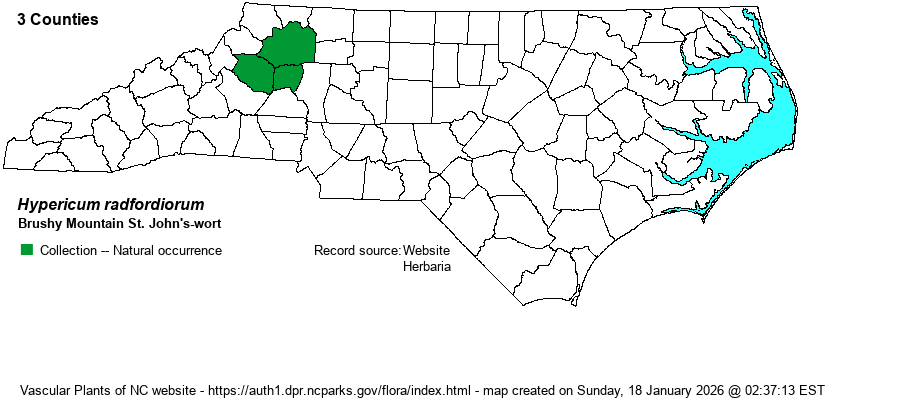| Author | Weakley ex J.R. Allison | |
| Distribution | This recently described species is a very narrow NC endemic, found only in the Brushy Mountains of Alexander, Caldwell, and Wilkes counties in the northwestern Piedmont. Most records are in Alexander County.
The above three counties comprise the entire range.
| |
| Abundance | Though highly restricted in range, it is locally common on a handful of sites in the Brushy Mountains. It is a State Special Concern species. The NCNHP moved the State Rank up from S2 to S1S2 in 2024, and thus NatureServe should do the same, as the species is found only in NC. | |
| Habitat | The species is restricted to circumneutral soil of the thin mats of vegetation around granitic outcrops/domes in parts of the Brushy Mountains. It is not known from thin soil mats around other granitic domes in the foothills, such as at Stone Mountain State Park, as those soils are quite acidic. In fact, these high pH soils are home to a number of other rare species that are limited to such rich soils, such as Striped Garlic (Allium keeverae) and Wright’s Cliff-brake (Pellaea wrightiana). | |
| Phenology | Blooms and fruits from June to August. | |
| Identification | This herbaceous species is erect and has many branches, reaching about 1 foot tall. The similar H. virgatum (also split from H. denticulatum) grows in the central and lower Piedmont but not on exposed granitic domes; it has only a few branches, from the upper axils. In addition, the opposite leaves of H. radfordiorum are rather narrow to lanceolate and have acuminate tips and not acute or obtuse in the latter species, which has more elliptic or obovate leaves. The species, as do all of the three taxa in the H. denticulatum complex, has somewhat orange-yellow or golden-yellow petals that are rotate in shape and not symmetrical. | |
| Taxonomic Comments | This species was formally described only in 2011, split from H. denticulatum. In fact, most references, including RAB (1968), included this taxon within H. denticulatum var. acutifolium, which also contains another taxon. (That is, the new H. radfordiorum is not simply the former , but only that population from the Brushy Mountains).
| | Other Common Name(s) | Radford’s St. John’s-wort | | | State Rank | S1S2 [S2] | | | Global Rank | G2 | | | State Status | SC-V | | | US Status | | | | USACE-agcp | | | | USACE-emp | | | |

